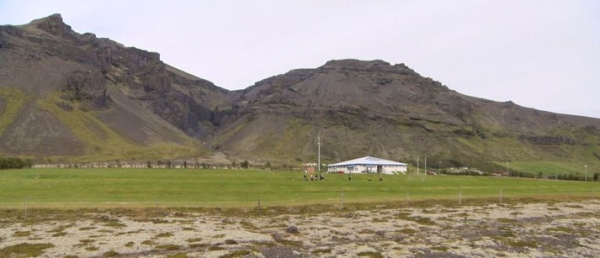A new village is emerging in the foothills of Öræfajökull, the southernmost tip of Vatnajökull glacier: Hof. Three new streets are being built and soon the local government will grant building permits for houses containing eighteen new apartments. Hof will become the only urban center between the village of Kirkjubæjarklaustur in South Iceland and the small town of Höfn in the South East. The distance between Kirkjubæjarklaustur and Höfn is 200 km (125 m).
From a cluster of farms to a small village

Hof is currently nothing more than a cluster of farmhouses, including an old historic church, as well as a hotel and the local elementary school. The new village will be built around the elementary school. The area has seen a significant population increase in recent years, thanks to booming tourism in the area south of Vatnajökull glacier and National Park. One of Iceland's most popular tourist destinations, Jökulsárlón glacial lagoon is to the east of Hof.
The booming tourism has brought with it a housing shortage in the region. Tourism companies are among those who have been calling for new housing in the region. The local TV station Channel 2 reports that the municipal authority has also had trouble finding housing for its employees, including the principal at the elementary school. In the absence of new residential construction the municipality will have a hard time attracting teachers and other employees.
Foothills of a terrifying volcano

The Öræfi region is located in the western foothills of Öræfajökull glacier. Öræfajökull glacier covers a giant volcano which last erupted in 1727. The Öræfajökull volcano erupts in giant steam-blast eruptions, also known as phreatic or ultravolcanian eruptions. One of the best known steam-blast eruptions in history is the 1883 Krakatoa eruption. Steam-blast eruptions occur when magma heats ground water, creating a near-instantaneous evaporation and explosion which can eject enormous quantities of ash, rock and volcanic material which is then deposited over surrounding areas.
A 1362 eruption in Öræfajökull was the second deadliest eruption in Icelandic history. It destroyed one of the most prosperous farmland regions in South Iceland, killing all inhabitants and livestock at 20-40 farms in a region which was known then as Litla-hérað. Following the eruption, which deposited 10 cubic kilometers of volcanic material over fields and farms in the region, it's name changed to Öræfi, which translates as Wasteland in modern Icelandic.
The 1362 eruption is considered to be the largest tepthra eruption in the world in the last 1000 years. There is very little reason for concern, however, as the volcano erupts only once every several hundred years.
A new village is emerging in the foothills of Öræfajökull, the southernmost tip of Vatnajökull glacier: Hof. Three new streets are being built and soon the local government will grant building permits for houses containing eighteen new apartments. Hof will become the only urban center between the village of Kirkjubæjarklaustur in South Iceland and the small town of Höfn in the South East. The distance between Kirkjubæjarklaustur and Höfn is 200 km (125 m).
From a cluster of farms to a small village

Hof is currently nothing more than a cluster of farmhouses, including an old historic church, as well as a hotel and the local elementary school. The new village will be built around the elementary school. The area has seen a significant population increase in recent years, thanks to booming tourism in the area south of Vatnajökull glacier and National Park. One of Iceland's most popular tourist destinations, Jökulsárlón glacial lagoon is to the east of Hof.
The booming tourism has brought with it a housing shortage in the region. Tourism companies are among those who have been calling for new housing in the region. The local TV station Channel 2 reports that the municipal authority has also had trouble finding housing for its employees, including the principal at the elementary school. In the absence of new residential construction the municipality will have a hard time attracting teachers and other employees.
Foothills of a terrifying volcano

The Öræfi region is located in the western foothills of Öræfajökull glacier. Öræfajökull glacier covers a giant volcano which last erupted in 1727. The Öræfajökull volcano erupts in giant steam-blast eruptions, also known as phreatic or ultravolcanian eruptions. One of the best known steam-blast eruptions in history is the 1883 Krakatoa eruption. Steam-blast eruptions occur when magma heats ground water, creating a near-instantaneous evaporation and explosion which can eject enormous quantities of ash, rock and volcanic material which is then deposited over surrounding areas.
A 1362 eruption in Öræfajökull was the second deadliest eruption in Icelandic history. It destroyed one of the most prosperous farmland regions in South Iceland, killing all inhabitants and livestock at 20-40 farms in a region which was known then as Litla-hérað. Following the eruption, which deposited 10 cubic kilometers of volcanic material over fields and farms in the region, it's name changed to Öræfi, which translates as Wasteland in modern Icelandic.
The 1362 eruption is considered to be the largest tepthra eruption in the world in the last 1000 years. There is very little reason for concern, however, as the volcano erupts only once every several hundred years.







